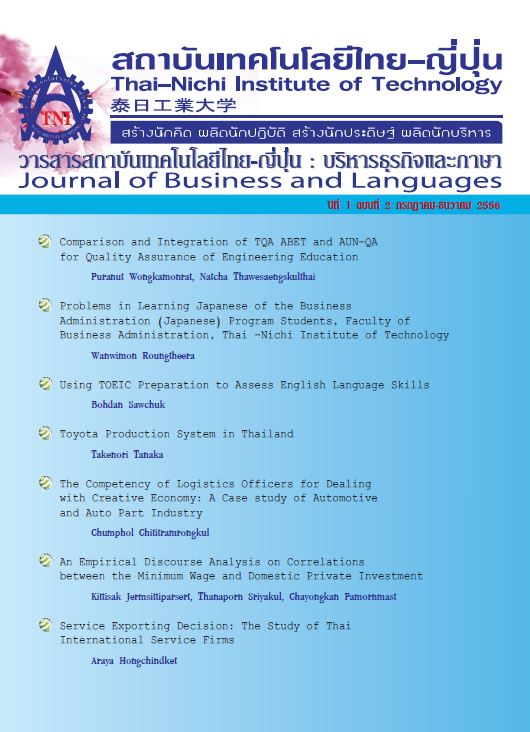Using TOEIC Preparation to Assess English Language Skills
Main Article Content
Abstract
All students at Thai-Nichi Institute of Technology (TNI) must complete nine required and six elective credits in English. In addition to those requirements for graduation, students are expected to achieve a minimum score of 600 on the TOEIC (test of English for International Communication). TNI students complete their required English courses in the first two years of their studies but are not required to take the TOEIC until their third or fourth year. We hypothesized that specific preparation for the TOEIC could be used to assess the English language skills of TNI students. Using random selection, we divided first-year students into three different groups. Each group was given identical TOEIC preparation material but the presentation of this material and the skills challenged would be different for each group. The results of the study indicated both the student's proficiency in English, and, the most effective method to present the preparation material.
Article Details
Article Accepting Policy
The editorial board of Thai-Nichi Institute of Technology is pleased to receive articles from lecturers and experts in the fields of business administration, languages, engineering and technology written in Thai or English. The academic work submitted for publication must not be published in any other publication before and must not be under consideration of other journal submissions. Therefore, those interested in participating in the dissemination of work and knowledge can submit their article to the editorial board for further submission to the screening committee to consider publishing in the journal. The articles that can be published include solely research articles. Interested persons can prepare their articles by reviewing recommendations for article authors.
Copyright infringement is solely the responsibility of the author(s) of the article. Articles that have been published must be screened and reviewed for quality from qualified experts approved by the editorial board.
The text that appears within each article published in this research journal is a personal opinion of each author, nothing related to Thai-Nichi Institute of Technology, and other faculty members in the institution in any way. Responsibilities and accuracy for the content of each article are owned by each author. If there is any mistake, each author will be responsible for his/her own article(s).
The editorial board reserves the right not to bring any content, views or comments of articles in the Journal of Thai-Nichi Institute of Technology to publish before receiving permission from the authorized author(s) in writing. The published work is the copyright of the Journal of Thai-Nichi Institute of Technology.
References
Cowell, W. R. (1980). Test analysis for Test of English for International Communication (ETS Statistical Report SR-80-13). Princeton, NJ: Educational Testing Service.
Educational Testing Service (1985b). Test of English for International Communication: Bulletin of information. Princeton, NJ: Author.
Educational Testing Service (1985c). Test of Spoken English: Manual for users. Princeton, NJ: Author.
Educational Testing Service (1986a). Guide for TOEIC users. Princeton, NJ: Author.
Educational Testing Service (1986b). TOEIC International Corporate Program. Princeton, NJ: Author.
Educational Testing Service (1988). Full range of English as a second language assessment programs under way at ETS, ETS Developments, XXXII, 5-8.
Hale, G. A., Stansfield, C. W., & Duran, R. P. (1984). Summaries of studies involving the Test of English as a Foreign Language, 1963-1982 (TOEFL Research Reports No. 16). Princeton, NJ: Educational Testing Service.
Jones, R. L., & Spolsky, B. (1975). (Eds.) Testing language proficiency. Arlington, VA: Center for Applied Linguistics.
Lynch,B.(1996) Language Program Evaluation London: Cambridge University Press
Ross, S.J.(2003) A diachronic coherence model for language program evaluation. Language Learning 53, 1. 1-33
Saegusa, Y. (1983). Japanese college students' reading proficiency in English, Musashino English and American Literature, 16, 99-117. (Tokyo, Japan: Musashino Women's University).
Saegusa, Y. (1985). Prediction of English Proficiency Progress, Musashino English and American Literature, 18, 165-185. (Tokyo, Japan: Musashino Women's University).
Saegusa, Y. (1989). Japanese company workers' English proficiency, WASEDA Studies in Human Sciences, 2, 1-12.


